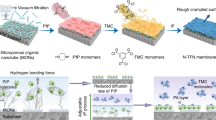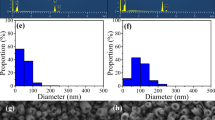Abstract
Robust monodisperse nanoporous membranes have a wide range of biotechnological applications, but are often difficult or costly to fabricate. Here, a simple technique is reported to produce free-standing TiO2 nanotubular membranes with through-hole morphology. It consists of a three-step anodization procedure carried out at room temperature on a Ti foil. The first anodization (1 h at 80 V) is used to pattern the surface of the metallic foil. Then, the second anodization (24 h at 80 V) produces the array of TiO2 nanotubes that will constitute the final membrane. A higher voltage anodization (3–5 min at 180 V) is finally applied to detach the TiO2 nanotubular layer from the underlying Ti foil. In order to completely remove the barrier layer that obstructs some pores of the membrane, the latter is etched 2 min in a buffered oxide etch solution. The overall process produces 60-μm-thick TiO2 nanotubular membranes with tube openings of 110 nm on one side and 73 nm on the other side. The through-hole morphology of these membranes has been verified by performing diffusion experiments with glucose, insulin, and immunoglobulin G where in differences in diffusion rate are observed based on molecular weight. Such biocompatible TiO2 nanotubular membranes, with controlled pore size and morphology, have broad biotechnological and biomedical applications.








Similar content being viewed by others
References
Grimes CA, Mor GK (2009) TiO2 nanotube arrays—synthesis, properties, and applications. Springer, Dordrecht
Roy P, Berger S, Schmuki P (2011) TiO2 nanotubes: synthesis and applications. Angew Chem Int Ed 50(13):2904–2939. doi:10.1002/anie.201001374
Kummer KM, Taylor E, Webster TJ (2012) Biological applications of anodized TiO2 nanostructures: a review from orthopedic to stent applications. Nanosci Nanotechnol Lett 4(5):483–493. doi:10.1166/nnl.2012.1352
Tan AW, Pingguan-Murphy B, Ahmad R, Akbar SA (2012) Review of titania nanotubes: fabrication and cellular response. Ceram Int 38(6):4421–4435. doi:10.1016/j.ceramint.2012.03.002
Ainslie KM, Tao SL, Popat KC, Daniels H, Hardev V, Grimes CA, Desai TA (2009) In vitro inflammatory response of nanostructured titania, silicon oxide, and polycaprolactone. J Biomed Mater Res A 91A(3):647–655. doi:10.1002/jbm.a.32262
Oh S-H, Finones RR, Daraio C, Chen L-H, Jin S (2005) Growth of nano-scale hydroxyapatite using chemically treated titanium oxide nanotubes. Biomaterials 26(24):4938–4943. doi:10.1016/j.biomaterials.2005.01.048
Brammer KS, Frandsen CJ, Jin S (2012) TiO2 nanotubes for bone regeneration. Trends Biotechnol 30(6):315–322. doi:10.1016/j.tibtech.2012.02.005
Minagar S, Berndt CC, Wang J, Ivanova E, Wen CA (2012) Review of the application of anodization for the fabrication of nanotubes on metal implant surfaces. Acta Biomater 8(8):2875–2888. doi:10.1016/j.actbio.2012.04.005
Brammer KS, Oh S, Gallagher JO, Jin S (2008) Enhanced cellular mobility guided by TiO2 nanotube surfaces. Nano Lett 8(3):786–793. doi:10.1021/nl072572o
Peng L, Eltgroth ML, LaTempa TJ, Grimes CA, Desai TA (2009) The effect of TiO2 nanotubes on endothelial function and smooth muscle proliferation. Biomaterials 30(7):1268–1272. http://www.sciencedirect.com/science/article/pii/S0142961208008818. Accessed 14 Oct 2013
Peng L, Barczak AJ, Barbeau RA, Xiao Y, LaTempa TJ, Grimes CA, Desai TA (2009) Whole genome expression analysis reveals differential effects of TiO2 nanotubes on vascular cells. Nano Lett 10(1):143–148. doi:10.1021/nl903043z
Popat KC, Eltgroth M, LaTempa TJ, Grimes CA, Desai TA (2007) Decreased Staphylococcus epidermis adhesion and increased osteoblast functionality on antibiotic-loaded titania nanotubes. Biomaterials 28(32):4880–4888. doi:10.1016/j.biomaterials.2007.07.037
Popat KC, Eltgroth M, LaTempa TJ, Grimes CA, Desai TA (2007) Titania nanotubes: a novel platform for drug-eluting coatings for medical implants? Small 3(11):1878–1881. doi:10.1002/smll.200700412
Peng L, Mendelsohn AD, LaTempa TJ, Yoriya S, Grimes CA, Desai TA (2009) Long-term small molecule and protein elution from TiO2 nanotubes. Nano Lett 9(5):1932–1936. doi:10.1021/nl9001052
Losic D, Simovic S (2009) Self-ordered nanopore and nanotube platforms for drug delivery applications. Expert Opin Drug Deliv 6(12):1363–1381. doi:10.1517/17425240903300857
Albu SP, Ghicov A, Macak JM, Hahn R, Schmuki P (2007) Self-organized, free-standing TiO2 nanotube membrane for flow-through photocatalytic applications. Nano Lett 7(5):1286–1289. doi:10.1021/nl070264k
Paulose M, Prakasam HE, Varghese OK, Peng L, Popat KC, Mor GK, Desai TA, Grimes CA (2007) TiO2 nanotube arrays of 1000 μm length by anodization of titanium foil: phenol red diffusion. J Phys Chem C 111(41):14992–14997. doi:10.1021/jp075258r
Paulose M, Peng L, Popat KC, Varghese OK, LaTempa TJ, Bao N, Desai TA, Grimes CA (2008) Fabrication of mechanically robust, large area, polycrystalline nanotubular/porous TiO2 membranes. J Membr Sci 319(1–2):199–205. doi:10.1016/j.memsci.2008.03.050
Albu SP, Ghicov A, Berger S, Jha H, Schmuki P (2010) TiO2 nanotube layers: flexible and electrically active flow-through membranes. Electrochem Commun 12(10):1352–1355. doi:10.1016/j.elecom.2010.07.018
Roy P, Dey T, Lee K, Kim D, Fabry B, Schmuki P (2010) Size-selective separation of macromolecules by nanochannel titania membrane with self-cleaning (declogging) ability. J Am Chem Soc 132(23):7893–7895. doi:10.1021/ja102712j
Liu G, Wang K, Hoivik N, Jakobsen H (2012) Progress on free-standing and flow-through TiO2 nanotube membranes. Sol Energy Mater Sol Cells 98:24–38. doi:10.1016/j.solmat.2011.11.004
Macak JM, Albu SP, Schmuki P (2007) Towards ideal hexagonal self-ordering of TiO2 nanotubes. Phys Status Solidi 1(5):181–183. doi:10.1002/pssr.200701148
Zhang G, Huang H, Zhang Y, Chan HLW, Zhou L (2007) Highly ordered nanoporous TiO2 and its photocatalytic properties. Electrochem Commun 9(12):2854–2858. http://www.sciencedirect.com/science/article/pii/S1388248107004079. Accessed 14 Oct 2013
Ali G, Chen C, Yoo S, Kum J, Cho S (2011) Fabrication of complete titania nanoporous structures via electrochemical anodization of Ti. Nanoscale Res Lett 6(1):332. http://www.nanoscalereslett.com/content/6/1/332. Accessed 14 Oct 2013
Wang D, Liu L (2010) Continuous fabrication of free-standing TiO2 nanotube array membranes with controllable morphology for depositing interdigitated heterojunctions. Chem Mater 22(24):6656–6664. doi:10.1021/cm102622x
Kant K, Losic D (2009) A simple approach for synthesis of TiO2 nanotubes with through-hole morphology. Phys Status Solidi 3(5):139–141. doi:10.1002/pssr.200903087
Li S, Zhang G (2010) One-step realization of open-ended TiO2 nanotube arrays by transition of the anodizing voltage. J Ceram Soc Jpn 118(4):291–294. doi:10.2109/jcersj2.118.291
Jo Y, Jung I, Lee I, Choi J, Tak Y (2010) Fabrication of through-hole TiO2 nanotubes by potential shock. Electrochem Commun 12(5):616–619. doi:10.1016/j.elecom.2010.02.013
Liu G, Hoivik N, Wang K, Jakobsen H (2011) A voltage-dependent investigation on detachment process for free-standing crystalline TiO2 nanotube membranes. J Mater Sci 46(24):7931–7935. doi:10.1007/s10853-011-5927-4
Fang D, Huang K, Liu S, Luo Z, Qing X, Zhang Q (2010) High-density NiTiO3/TiO2 nanotubes synthesized through sol-gel method using well-ordered TiO2 membranes as template. J Alloys Compd 498(1):37–41. http://www.sciencedirect.com/science/article/pii/S092583881000410X. Accessed 14 Oct 2013
Zhu B, Li J, Chen Q, Cao R-G, Li J, Xu D (2010) Artificial, switchable K+-gated ion channels based on flow-through titania-nanotube arrays. Phys Chem Chem Phys 12(34):9989–9992. doi:10.1039/B925961A
Li L-L, Chen Y-J, Wu H-P, Wang NS, Diau EW-G (2011) Detachment and transfer of ordered TiO2 nanotube arrays for front-illuminated dye-sensitized solar cells. Energy Environ Sci 4(9):3420–3425. doi:10.1039/C0EE00474J
Pappenheimer JR, Renkin EM, Borrero LM (1951) Filtration, diffusion and molecular sieving through peripheral capillary membranes: a contribution to the pore theory of capillary permeability. Am J Physiol 167(1):13–46. http://ajplegacy.physiology.org/content/167/1/13. Accessed 14 Oct 2013
Oliva A, Fariña J, Llabrés M (2000) Development of two high-performance liquid chromatographic methods for the analysis and characterization of insulin and its degradation products in pharmaceutical preparations. J Chrom B 749(1):25–34. doi:10.1016/S0378-4347(00)00374-1
Leoni L, Desai TA (2004) Micromachined biocapsules for cell-based sensing and delivery. Adv Drug Deliv Rev 56(2):211–229. doi:10.1016/j.addr.2003.08.014
Kang J, Erdodi G, Kennedy JP (2007) Development of two high-performance liquid chromatographic methods for the analysis and characterization of insulin and its degradation products in pharmaceutical preparations. J Polym Sci A 45(18):4276–4283. doi:10.1002/pola.22170
Schweicher J, Nyitray C, Desai TA (2014) Membranes to achieve immunoprotection of transplanted islets. Front Biosci (accepted)
Acknowledgments
JS and TAD would like to acknowledge financial support from the Juvenile Diabetes Research Foundation. JS is also grateful for a postdoctoral fellowship (2010–2011) from the King Baudouin Foundation (Belgium) and the Belgian American Educational Foundation. All SEM imaging was performed at the Electron Microscope Facility of the San Francisco State University (SFSU).
Author information
Authors and Affiliations
Corresponding author
Rights and permissions
About this article
Cite this article
Schweicher, J., Desai, T.A. Facile synthesis of robust free-standing TiO2 nanotubular membranes for biofiltration applications. J Appl Electrochem 44, 411–418 (2014). https://doi.org/10.1007/s10800-013-0643-1
Received:
Accepted:
Published:
Issue Date:
DOI: https://doi.org/10.1007/s10800-013-0643-1




